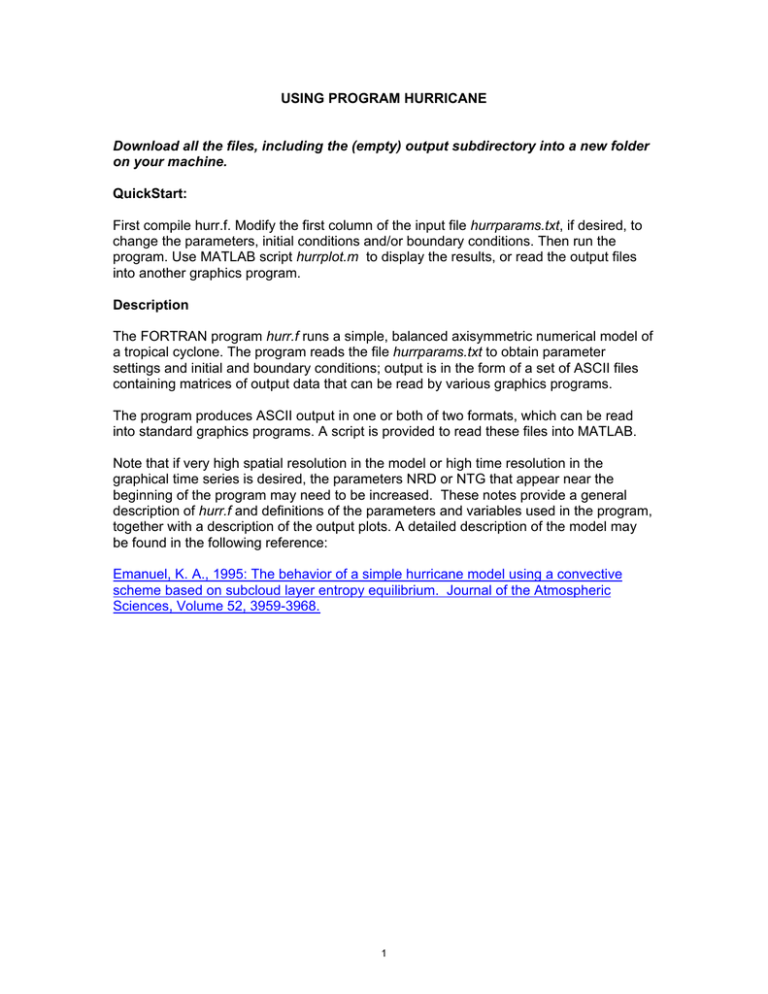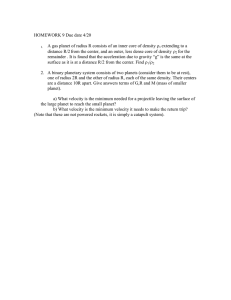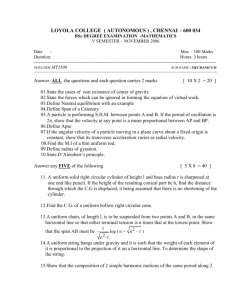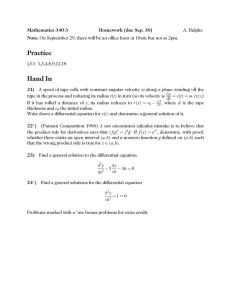USING PROGRAM HURRICANE QuickStart: hurrparams.txt
advertisement

USING PROGRAM HURRICANE Download all the files, including the (empty) output subdirectory into a new folder on your machine. QuickStart: First compile hurr.f. Modify the first column of the input file hurrparams.txt, if desired, to change the parameters, initial conditions and/or boundary conditions. Then run the program. Use MATLAB script hurrplot.m to display the results, or read the output files into another graphics program. Description The FORTRAN program hurr.f runs a simple, balanced axisymmetric numerical model of a tropical cyclone. The program reads the file hurrparams.txt to obtain parameter settings and initial and boundary conditions; output is in the form of a set of ASCII files containing matrices of output data that can be read by various graphics programs. The program produces ASCII output in one or both of two formats, which can be read into standard graphics programs. A script is provided to read these files into MATLAB. Note that if very high spatial resolution in the model or high time resolution in the graphical time series is desired, the parameters NRD or NTG that appear near the beginning of the program may need to be increased. These notes provide a general description of hurr.f and definitions of the parameters and variables used in the program, together with a description of the output plots. A detailed description of the model may be found in the following reference: Emanuel, K. A., 1995: The behavior of a simple hurricane model using a convective scheme based on subcloud layer entropy equilibrium. Journal of the Atmospheric Sciences, Volume 52, 3959-3968. 1 Input File hurrparams.txt 1. This file controls how the model behaves. There are three columns: The first is the value of the parameter that is actually read and used by the model. The second is the "normal" value that this parameter has, for reference. The third contains a description of the parameter. Most of these are self explanatory, but a few notes are in order: 2. The time interval over which plots are updated parameter sets the time resolution in the graphics displays and output files. The run time parameter (converted to hours) divided by this time interval should not exceed 600,otherwise (for those compiling their own version) change the parameter NTG to a higher value. 3. The maximum radius in plots parameter just controls the outermost radius in the plots; it does not affect the model integration. 4. In the standard run, the model is initialized with a weak, warm-core vortex. If desired, the model can instead be initialized from the fields produced at the end of the last run of the program. Errors may occur, however, if the control parameters differ from those used in the last run. All runs produce the file output/restart, which is then read if Restart from the last run is set to 'y'. 5. Unless the restart option is used, the model is initialized with a weak, warm-core vortex whose initial maximum surface wind, radius of maximum surface wind, and outer radius of the vortex can be specified. Note that the latter should not be too near the outer wall of the model, whose radius is specified later in the hurrparams.txt file. One may also specify an initial condition in which the storm core, inside a specified radius, has elevated humidity. 6. The atmospheric parameters include the (unperturbed) sea surface temperature, the mean outflow temperature (usually that of the tropopause, but in general the ambient temperature at the highest level to which convection in the storm core penetrates), and an ambient boundary layer relative humidity. Please note that this last really controls the ambient temperature profile of the tropical troposphere. It is assumed that the unperturbed atmosphere has a temperature profile given by a dry adiabat extending from the surface, at sea surface temperature, to the lifted condensation level (LCL), by a moist adiabat extending from the LCL to the tropopause, and by constant absolute temperature in the stratosphere. Thus changing the boundary layer relative humidity parameter changes this profile by moving the LCL. For example, setting this to 100% gives a moist adiabat extending from the surface, at sea surface temperature, to the tropopause, thus eliminating the potential for tropical cyclones altogether. 2 7. A proxy for the effect of vertical wind shear is included. (The model is axisymmetric, so shear cannot be included directly. Here, low entropy air at the model's middle level is advected into the core in proportion to the square of the shear.) If the time at which shear commences is greater than the model run time, no shear will affect the model run. 8. The storm is assumed to make landfall at the time specified by time until storm makes landfall. If this is greater than the model run time, no landfall occurs. Several different types of land surface can be specified. Plains, hills, and mountains differ only in the assumed value of the surface drag coefficient; the surface enthalpy flux is set to zero. For the swamp, the drag coefficient is assumed to be the same as a calm ocean surface, and the temperature of the swamp water is calculated as a function of time from the surface energy balance (not including radiation). (Note that when the storm is over the ocean, the values of the momentum and enthalpy exchange coefficients depend on wind speed.) 9. The storm can interact with a string of one-dimensional ocean columns, which are mixed owing to wind-induced shear at the base of the ocean's mixed layer. (See Nature paper for a description.) For this purpose, the translation of the storm across the sea must be specified. One can specify and ocean eddy whose unperturbed surface temperature is assumed to be that of the surrounding ocean, but which has a Gaussianshaped mixed layer depth anomaly which can be positive (warm eddy) or negative (cold eddy). (If negative, be sure its value does not exceed that of the unperturbed ocean mixed layer, which is specified near the near of the file.) Advanced parameters: See Emanuel (1995; reference and hyperlink given above) for details. Output Text Files In the hurrparams.txt file, one may specify one of two formats for the ASCII text output files. The "tab" option: Specifying "tab" yields ASCII text files in space-separated format that can be read by MATLAB and other programs. If you are using MATLAB, there is no need to be concerned with the format of these files. Simply typing "hurrmenu" at the MATLAB prompt will bring up the following sequence of plots: Line plots showing evolution with time of: 1. Maximum azimuthal velocity at surface. The dashed line shows the theoretical maximum value. 2. Physical radius of maximum azimuthal velocity at surface. 3 3. Minimum azimuthal velocity at tropopause. 4. Physical radius of minimum azimuthal velocity at tropopause. 5. Central surface pressure. The dashed line shows the theoretical minimum value. 6. Maximum updraft volume flux. 7. Minimum downdraft volume flux. 8. Storm center ocean mixed layer depth. 9. Storm center sea surface temperature anomaly. Line plots of quantities as functions of physical radius at the final time: 10. Surface azimuthal velocity. 11. Tropopause azimuthal velocity. 12. Surface pressure. 13. Radial mass flux integrated from surface to middle level (solid) and from surface to top of boundary layer (dashed). 14. Cumulus updraft mass flux (dashed) and the clear air vertical velocity multiplied by 10 (solid). 15. Boundary layer entropy variable (solid), lower troposphere entropy variable (dashed) and tropospheric saturation entropy variable (dotted). 16. Ocean mixed layer depth. 17. Sea surface temperature anomaly. The next 8 plots are two-dimensional plots in the r-z plane of various quantities at the final time of the simulation. They have been made by mapping the R-T fields of the model back into physical space using a linear interpolator. These fields have been calculated by assuming that the interior vortex is slantwise neutral, following Emanuel, 1986, J. Atmos. Sci., Vol. 43, pp. 585-604. The streamfunction and its derivatives (vertical and radial velocity) have also been mapped from the model variables PS0 and PS2 assuming interior neutrality. In the radial velocity plot, it has been assumed that the frictional component of the inflow all occurs within a layer that is DELP thick. The rain water concentration had been calculated by solving a simple rainwater equation using the model's vertical velocity. 18. Azimuthal velocity. 19. Radial velocity calculated from streamfunction in plot 21. 4 20. Vertical velocity calculated from streamfunction in plot 21. 21. Streamfunction, calculated by assuming that the actual (continuous) vertical velocity field acts to keep the flow slantwise neutral at all times and places....and mapping the discrete streamfunction (PS0 and PS2) used by the model accordingly. The dimensional version of the plot is in 10**-8 mks units (kg m/(s**3)). The streamfunction is assumed to decay to zero in the subcloud layer as defined by the parameter DELP. 22. Difference between the pressure at a given point and the pressure at the same physical altitude at the periphery of the storm. Note that in the nondimensional version of this plot, the perturbation of the nondimensional variable P has been normalized by multiplying it by exp(BETA*PB), where PB is P at the outer boundary. 23. Difference between the temperature at a given point and the temperature at the same altitude in the environment. The "nondimensional" version is also given in units of degrees K. 24. Equivalent potential temperature (or Chi, in nondimensional plots), made by fitting a function of the form sin(z**n) to the variables X2(I), XM2(I) and XS2(I) such that X2 is realized at the surface and at the tropopause, and XM2 at a level where the absolute temperature is 0.2 of the interval between the surface and tropopause temperatures. 25. Rain water concentration. This is not a model variable, but is calculated by solving a simple diagnostic rainwater equation from the model's vertical velocity field. Other graphics packages may be able to read the MATLAB-format files. There are several different files, all containing floating point numbers separated by spaces: Time.out: A matrix of numbers the first column of which contains time, with each successive column containing numbers corresponding to: Surface maximum velocity, theoretical maximum velocity, radius of maximum winds, minimum velocity at tropopause, radius of minimum tropopause winds, central surface pressure, theoretical minimum central surface pressure, maximum updraft speed, minimum downdraft speed, mixed layer depth at storm center, and sea surface temperature anomaly at storm center. Radius.out: A similar matrix containing quantities at the final time step of the model run. The first column represents radius, with successive columns corresponding to: radius at the thermodynamic points, radius of points at the tropopause, surface azimuthal wind, tropopause azimuthal wind, surface pressure, boundary layer average radial wind, lower troposphere average radial wind, updraft speed, subsidence velocity, equivalent potential temperature of the boundary layer, saturation equivalent potential temperature aloft, lower troposphere equivalent potential temperature, ocean mixed layer depth, sea surface temperature anomaly, and boundary layer relative humidity. Rgraph.out: A vector containing radii of contour graph quantities. 5 Zgraph.out: A vector containing altitudes of contour graph quantities. A set of 2-D matrices. In each case, the column index is radius while the row index is height, with height increasing downward in the array: vcon.out: Azimuthal velocity ucon.out: Radial velocity wcon.out: Vertical velocity Psicon.out: Mass streamfunction pcon.out: Perturbation pressure Tcon.out: Perturbation temperature Tecon.out: Equivalent potential temperature Raincon.out: Rainwater content calculated from the vertical velocity The "csv" option: This produces output identical to the MATLAB files with the following exceptions: 1. All floating point numbers and text are separated by commas 2. The first row of the files time.csv and radius.csv are text headers describing the quantities in each column 3. The first row of the files vcon.csv, ucon.csv, etc. has the radial coordinates identical to the content of the radius.out file described above 4. The first column of the files vcon.csv, ucon.csv, etc. contain the altitudes corresponding to the vector zgraph.out described above 5. The altitudes in the vcon.csv, ucon.csv, etc. files DECREASE downward in the files. 6. There are no equivalents of the files rgraph.out and zgraph.out These files are "text matrix" files that can be read by a variety of commercial graphics packages. DEFINITIONS OF PARAMETERS AND VARIABLES Most of the model parameters, the initial and boundary conditions, and specifications of the integration time, time step, model domain and horizontal resolution are described in the input file hurrparams.txt. Note that, for historical reasons, all parameters and dependent and independent variables are first nondimensionalized before the model is 6 run. The following nondimensional quantities are specified or calculated within the main program: DR: The grid length in R space. NT: The number of time steps in the integration. DAMP: The damping coefficient in the time smoother of the leap frog scheme. BFAC: A coefficient used in the open boundary condition on the streamfunction. PBM: A small number determining the accuracy of the relaxation of the elliptic equation for psi. DEPENDENT VARIABLES In the following, the last number (i.e. 1, 2 or 3) of the variable name indicates the time level of the variable. These are all nondimensional quantities. RBS: The square of the physical radius, r, at the top of the boundary layer (a dependent variable in this model). RTS: Ditto, but evaluated at the tropopause. XS: The saturation entropy at the middle level. X: The boundary layer entropy. XM: The entropy of the lower layer. MU: The cumulus updraft mass flux. DIAGNOSED QUANTITIES RMS: Physical radius squared, evaluated at the middle level. RB1, RB2: The physical radius at the sea surface (two time levels). RT1: The physical radius at the tropopause (one time level). PS: The streamfunction at the middle level of the model. PS0: The streamfunction at the top of the boundary layer due to Ekman pumping alone. The "G" term is added when needed to give the clear air velocity at the top of the subcloud layer. P: Surface pressure. GB: The radially integrated deep cloud mass flux. VIS: The diffusion term in the lower layer momentum equation. 7 VIS2: The diffusion term in the upper layer momentum equation. XVIS: The diffusion term in the equation for XS. XMVIS: The diffusion term in the equation for XM. TT: The current time in the integration. The following may be also useful to know: PF: The subsidence term of the XS equation. PF1: The vertical advection term at the middle level for the XM equation. VB: In general, the azimuthal velocity. UB: Proportional to the radial velocities used for advections in the boundary layer. ADV: The radial advection term in the X equation. ADVM: The radial advection term in the M equation. MF: The right-hand side of the M equation. W0: The vertical velocity at the top of the boundary layer. W0D: The clear air vertical velocity at the top of the boundary layer. XMF: The right-hand side of the XM equation. FLUX: The surface entropy flux and the dissipative heating. XF: The right hand side of the X equation (not including radiation). 8 MIT OpenCourseWare http://ocw.mit.edu 12.811 Tropical Meteorology Spring 2011 For information about citing these materials or our Terms of Use, visit: http://ocw.mit.edu/terms. 9




